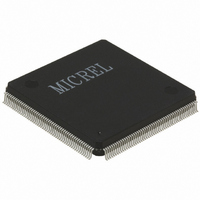KS8999 Micrel Inc, KS8999 Datasheet - Page 21

KS8999
Manufacturer Part Number
KS8999
Description
IC SWITCH 10/100 9PORT 208PQFP
Manufacturer
Micrel Inc
Specifications of KS8999
Applications
*
Mounting Type
Surface Mount
Package / Case
208-MQFP, 208-PQFP
Fiber Support
Yes
Integrated Led Drivers
Yes
Phy/transceiver Interface
MII/SNI
Power Supply Type
Analog/Digital
Package Type
PQFP
Data Rate (typ)
10/100Mbps
Vlan Support
Yes
Operating Temperature (max)
70C
Operating Temperature (min)
0C
Mounting
Surface Mount
Jtag Support
No
Operating Temperature Classification
Commercial
Lead Free Status / RoHS Status
Contains lead / RoHS non-compliant
For Use With
576-1023 - BOARD EVAL EXPERIMENT FOR KS8999
Lead Free Status / RoHS Status
Not Compliant, Contains lead / RoHS non-compliant
Available stocks
Company
Part Number
Manufacturer
Quantity
Price
Part Number:
KS8999
Manufacturer:
PRX
Quantity:
20 000
January 2005
Micrel, Inc.
Functional Overview: Switch Core
Address Look-Up
The internal look-up table stores MAC addresses and their associated information. It contains 1K full CAM with 48-bit
address plus switching information. The KS8999 is guaranteed to learn 1K addresses and distinguishes itself from
hash-based lookup tables which, depending on the operating environment and probabilities, may not guarantee the
absolute number of addresses it can learn.
Learning
The internal look-up engine will update its table with a new entry if the following conditions are met:
• The received packet’s SA does not exist in the look-up table.
• The received packet is good; the packet has no receiving errors, and is of legal length.
The look-up engine will insert the qualified SA into the table, along with the port number, time stamp.
If the table is full, the last entry of the table will be deleted first to make room for the new entry.
Migration
The internal look-up engine also monitors whether a station is moved. If it happens, it will update the table
accordingly. Migration happens when the following conditions are met:
• The received packet’s SA is in the table but the associated source port information is different.
• The received packet is good; the packet has no receiving errors, and is of legal length.
The look-up engine will update the existing record in the table with the new source port information.
Aging
The look-up engine will update time stamp information of a record whenever the corresponding SA appears. The
time stamp is used in the aging process. If a record is not updated for a period of time, the look-up engine will then
remove the record from the table. The look-up engine constantly performs the aging process and will continuously
remove aging records. The aging period is 300 seconds. This feature can be enabled or disabled by external pull-up
or pull-down resistors.
Forwarding
The KS8999 will forward packets as follows:
• If the DA look-up results is a “match”, the KS8999 will use the destination port information to determine where the
• If the DA look-up result is a “miss”, the KS8999 will forward the packet to all other ports except the port that
• All the multicast and broadcast packets will be forwarded to all other ports except the source port.
• The KS8999 will not forward the following packets:
• Error packets. These include framing errors, FCS errors, alignment errors, and illegal size packet errors.
• 802.3x pause frames. The KS8999 will intercept these packets and do the appropriate actions.
• “Local” packets. Based on destination address (DA) look-up. If the destination port from the look-up table matches
Switching Engine
The KS8999 has a very high performance switching engine to move data to and from the MAC’s, packet buffers. It
operates in store and forward mode, while the efficient switching mechanism reduces overall latency.
The KS8999 has an internal buffer for frames that is 32Kx32 (128KB). This resource could be shared between the
nine ports and is programmed at system reset time by using the unmanaged program mode (I/O strapping).
Each buffer is sized at 128B and therefore there are a total of 1024 buffers available. Two different modes are
available for buffer allocation. One mode equally allocates the buffers to all the ports (113 buffers per port). The other
mode adaptively allocates buffers up to 512 to a single port based on loading. Selection is achieved by using
LED[7][1] in the unmanaged programming description.
packet goes.
received the packet.
the port where the packet was from, the packet is defined as “local”.
21
KS8999
KS8999












